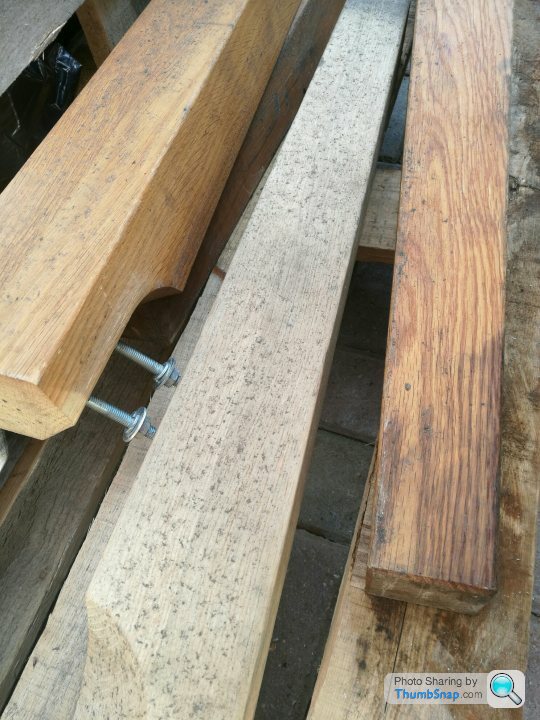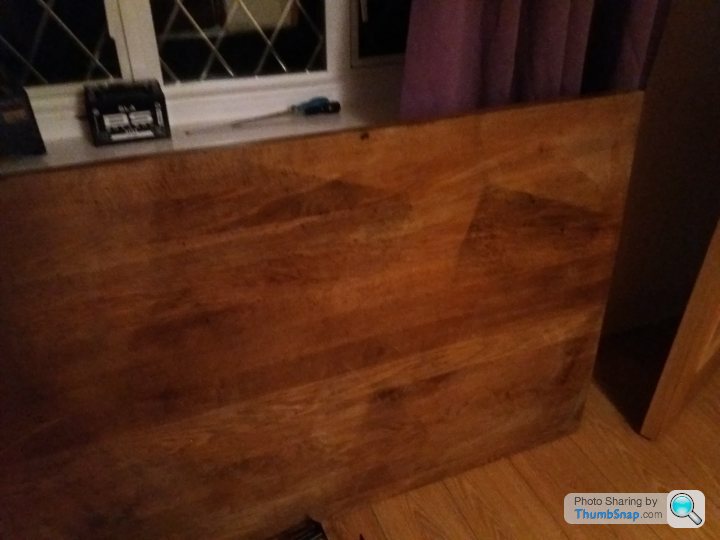Oak table covered in crap
Discussion
Have what looks like an oak table (very solid and heavy) delivered that has been left outside for a while. Covered in bits of black crap which I assume are water marks.
I have tried to clean with water (Last three pics are after cleaning with a damp cloth, its not varnished.) Some of the muck came off but not much. I then tried a scourer, again not much joy.
I have some oxalic acid in the garage but never used it before. Woudl this do the job?







I have tried to clean with water (Last three pics are after cleaning with a damp cloth, its not varnished.) Some of the muck came off but not much. I then tried a scourer, again not much joy.
I have some oxalic acid in the garage but never used it before. Woudl this do the job?







Whatever you do to clean it up, DON'T use steel wool in the finishing process, bits of the steel wool will break off and lodge in the grain of the oak, this WILL turn to rust by the tannin's in the oak.
Keep all steel tools away from oak, savings and sawdust or they will rust almost immediately,
Keep tools clean after use.
Keep all steel tools away from oak, savings and sawdust or they will rust almost immediately,
Keep tools clean after use.
Edited by Big Al. on Wednesday 21st March 09:10
Big Al. said:
Whatever you do to clean it up, DON'T use steel wool in the finishing process, bits of the steel wool will break off and lodge in the grain of the oak, this WILL turn to rust by the tannin's in the oak.
Keep all steel tools away from oak, savings and sawdust or they will rust almost immediately,
Keep tools clean after use.
Beg to differ. I used to make sure when splitting wood, that I finished with oak. The tannins in the oak would coat the blade which quickly turned black, but then did not rust and kept its edge.Keep all steel tools away from oak, savings and sawdust or they will rust almost immediately,
Keep tools clean after use.
But in any case, dont use wire wool. As others have saind, let it dry out properly and sand it right back and refinish.
Belt sander would be a bit harsh and unlikely to leave it flat unless you're really careful. For a flat surface top a random orbit would be better.
Personally I'd avoid sanding at first and try the oxalic on a discrete bit and see how you get on if the problem is staining rather than surface damage, or at least surface damage needing only light refinishing.
For one thing you won't need to remove huge amounts of wood to get rid of the stains - they'll go below the surface so sanding isn't a brilliant way to remove them - and oxalic will clear the tannins right away. A hot solution is fastest.
Just make sure to rinse it off and dry it properly and be careful of any dust from sanding afterwards. Make sure you don't leave water anywhere especially joints as it'll inevitably lead to new stains.
Personally I'd avoid sanding at first and try the oxalic on a discrete bit and see how you get on if the problem is staining rather than surface damage, or at least surface damage needing only light refinishing.
For one thing you won't need to remove huge amounts of wood to get rid of the stains - they'll go below the surface so sanding isn't a brilliant way to remove them - and oxalic will clear the tannins right away. A hot solution is fastest.
Just make sure to rinse it off and dry it properly and be careful of any dust from sanding afterwards. Make sure you don't leave water anywhere especially joints as it'll inevitably lead to new stains.
Edited by Jonesy23 on Wednesday 21st March 00:03
Don't listen to the sand it merchants they don't know what they are looking at.
I've built a green oak framed house & part of the post erection of the frame is a proper going over the whole thing with a dissolved Oxalic acid solution scrubbed in with a bronze finish brush then washing off with plenty of water. Doing that will have it looking like new in no time assuming it was an unvarnished or unsealed oak piece in the first place.
Representative before & after Oxalic below-


I've built a green oak framed house & part of the post erection of the frame is a proper going over the whole thing with a dissolved Oxalic acid solution scrubbed in with a bronze finish brush then washing off with plenty of water. Doing that will have it looking like new in no time assuming it was an unvarnished or unsealed oak piece in the first place.
Representative before & after Oxalic below-


Paul Drawmer said:
Beg to differ. I used to make sure when splitting wood, that I finished with oak. The tannins in the oak would coat the blade which quickly turned black, but then did not rust and kept its edge.
I still have the rusted steel rules and planes, planes were OK with a bit of a clean up with wet & dry, steel rules on the other hand can only be used as straight edges, no lasered engraving remains. If you have the proper crystals it should give you a guide on the label, if not with the stuff I have it doesn't appear to be very sensitive to exact quantity I just do half a bucket of hotish water then a cup of crystals give it a good stir until its all dissolved & crack on with it.
Its not pleasant stuff though so goggles / latex waterproof gloves or similar to protect you from it & make sure you wash it off after with plenty of fresh water or you will be in big trouble if you want to sand it afterwards as its very nasty to inhale the sand dust with it in it so must use a dust mask if you do.
Its not pleasant stuff though so goggles / latex waterproof gloves or similar to protect you from it & make sure you wash it off after with plenty of fresh water or you will be in big trouble if you want to sand it afterwards as its very nasty to inhale the sand dust with it in it so must use a dust mask if you do.
Big Al. said:
I still have the rusted steel rules and planes, planes were OK with a bit of a clean up with wet & dry, steel rules on the other hand can only be used as straight edges, no lasered engraving remains.
Funnily enough oxalic acid is great for sorting rust as well as tannin stains...KAgantua said:
cheers mate will do, how much solution of oxalic acid in water, do you happen to know please ta
One option is to add crystals to the point where they stop dissolving, and hot water will allow for a stronger solution.Alternatively you could try a weaker solution and just test it (brush it on, no need to scrub) to see how well it works. If it doesn't react enough strengthen the solution. It's usually instant.
Personally I used to go for a saturated hot solution.
The cleanup is the bit that takes time and the stronger the solution the longer this will take as you've more oxalic to remove.
Gassing Station | Homes, Gardens and DIY | Top of Page | What's New | My Stuff



